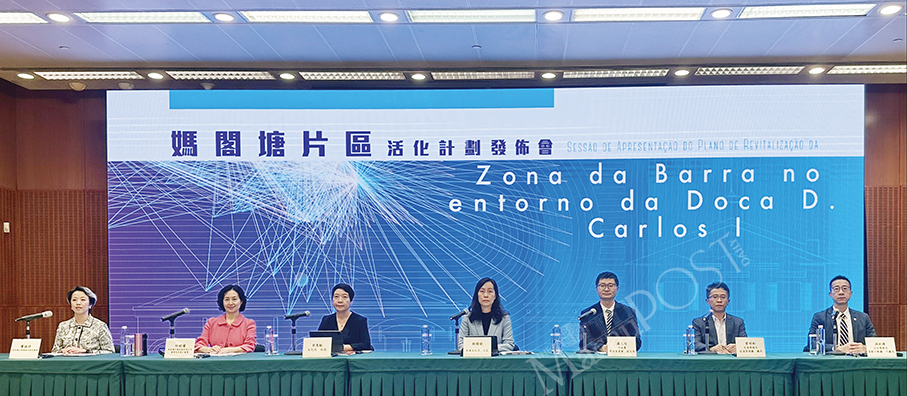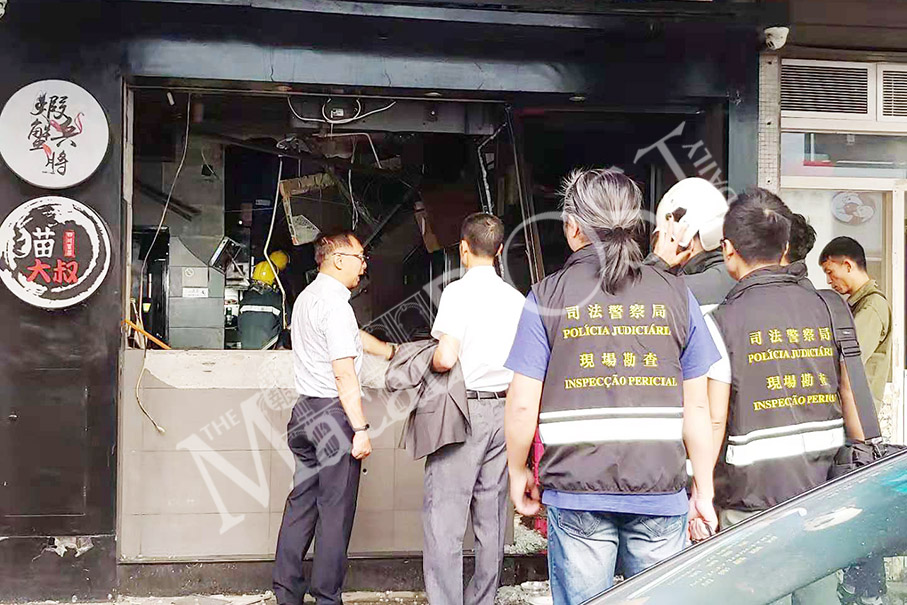The government and integrated resort (IR) operator MGM announced yesterday at a joint press conference at the Macau Cultural Centre their plan for a revitalisation project of 13 buildings surrounding Doca D. Carlos I in the Barra neighbourhood, covering an area of about 35,000 square metres.
“Barra” is Portuguese for “harbour entrance”. Barra is commonly known as Ma Kok in Cantonese – due to the nearby Ma Kok (A-Ma) Temple. “Doca” is the Portuguese word for “dock”. D. Carlos I was King of Portugal between 1889 and his assassination in Lisbon in 1908.
Cultural Affairs Bureau (IC) President Leong Wai Man noted during the press conference that based on the principles of architectural conservation, community development and cultural promotion, the project will dig deeply into the “historical stories” of the neighbourhood, creating a new urban public interface with local cultural characteristics and sustainable development.
The Barra area around Doca D. Carlos I and its surroundings are rich in cultural resources, Leong said, adding she believed that combining it with the “original route” of the historic centre as the city’s UNESCO World Heritage Site, the supporting facilities of the Barra Transport Hub and the distinctive buildings and spaces, the area would be created as a “cultural and creative park” with unique and attractive leisure activities, which could improve the quality of residents’ cultural life and provide the public with rich cultural resources.
According to Leong, the area ready for revitalisation consists of “commercial facilities with a relatively complete maritime culture and history that still exists in Macau”, mainly composed of the erstwhile shipbuilding, machinery and carpentry workshops at the former navy shipyard, as well as the Harbour Master’s Office and municipal abattoir in the past, among others, testifying to the development and changes of the area since the end of the 19th century. Leong pointed out that there are still many buildings with commercial features, forming a cluster of buildings once used for manufacturing with the area as the centre, “which together with the surrounding natural resources shape a unique historical cultural and landscape atmosphere”.
Being an area with the most comprehensive maritime history, culture and manufacturing facilities, Leong said, the forms and models of the trade in the area’s surroundings were relatively homogeneous, “with a functional response to the landscape, [later] causing a lack of people flow and economic vitality in the neighbourhood.”
Leong pointed out that the buildings in the area are nowadays mainly used by the Cultural Affairs Bureau and the Municipal Affairs Bureau (IAM), among other government entities, among which the Cultural Affairs Bureau has previously revitalised some buildings such as by converting the machinery and carpentry workshops of the former navy shipyard into the Contemporary Art Centre, known as Navy Yard 1 and 2, while the original shipbuilding, maintenance buildings and abattoir are currently used as IAM workshops, office space, warehouses and storage facilities for government files.
In the press conference, MGM China Holdings Limited’s Co-Chairperson and Executive Director Pansy Ho Chiu King said that in line with the development of Macau’s cultural undertakings and cultural industries, the revitalisation plan will cover cultural and creative stores, art exhibitions, café terraces, speciality catering, art performances and art installations, among others. With the aim of attracting people into the old quarters and creating a diversified leisure tourism experience, according to Ho, the plan also aims to connect the Barra area with the core areas of the Ruins of St. Paul’s and the core route of the local UNESCO World Heritage and the surrounding tourism resources.
As it is a large-scale revitalisation project which needs time to be evaluated, there is no timetable and budget estimate for the time being, Ho said, promising that the historical value of the area would be well utilised in the project.
Regarding the suggestions to display Macau’s first jetfoil in the area, Ho said that Macau’s coastal waters were not deep enough and the area’s conditions were insufficient, so technically the suggestions were not feasible.
Attending yesterday’s press conference, Secretary for Social Affairs and Culture Elsie Ao Ieong U said that in order to revitalise the area, the offices of various government entities, such as the Macau Customs Service headquarters, in the area will soon move out, after which the area’s electricity supply and flood prevention facilities will be built underground.
6 IR operators to take part in 6 historic areas’ revitalisation projects
Meanwhile, Ao Ieong said in a speech that the government was committed to protecting Macau’s diverse cultural features, promoting the transformation and utilisation of cultural resources, leveraging the positioning advantages of building a “One Base”, supporting its “1+4” strategy of ensuring the local economy’s appropriately diversified development, leading the revitalisation of historic areas, shaping more distinctive cultural and community projects, and opening up space for cultural and tourism development, so as to better revitalise the local neighbourhoods and stimulate the development of small- and medium-sized enterprises (SMEs).
“One Base” refers to the government’s strategy for Macau to promote cultural exchanges and cooperation with Chinese culture as the mainstream. The government’s “1+4” development strategy comprises “big health”, modern finance, high tech, and conventions and exhibitions as well as culture and sport.
According to Ao Ieong, under the leadership of the government and in conjunction with the city’s six integrated tourism and leisure enterprises, they have started to jointly carry out the revitalisation of six historic areas, covering the already announced revitalisation of the Barra area in cooperation with MGM and the pedestrianisation of Rua da Felicidade in cooperation with Wynn, as well as the revitalisation projects of Pier 23 and 25 in the Inner Harbour district, the area comprising Avenida de Almeida Ribeiro and Rua de Cinco de Outubro, Taipa’s Iec Long Firecracker Factory, and Coloane’s Lai Chi Vun shipyards, the details of which have still to be announced, such as which of the other four IR operators will be involved in which particular project.
Ao Ieong said that the six areas boast architectural and historical features that are “quite rich”, with their locations playing a key role in revitalising the development of the city’s old quarters. However, at the same time, she added, there are difficulties in carrying out large-scale revitalisation projects with immature conditions and, therefore, it was necessary to complement large-scale and professional planning and use sound operation and management modes, so as to effectively utilise each of the six areas’ cultural tourism value and achieve the purpose of promoting community development.
The six IR operators involved in the revitalisation of the areas have rich operational experience in large-scale projects, and they have also made use of their resources to organise professional teams to contribute to the planning and revitalisation work of their respective areas, Ao Ieong pointed out.
Ao Ieong promised that the government will coordinate the implementation of the six revitalisation projects under the basic principles of highlighting the cultural and historical value of the respective areas, creating attractive new cultural and tourism attractions while stimulating the development of Macau’s cultural industries and SMEs.
Yesterday’s joint press conference was also attended by representatives of the Municipal Affairs Bureau, Transport Bureau (DSAT) and Public Security Police (PSP).
Government officials have previously pointed out that the six IR operators’ in the six revitalisation projects is part of the government’s effort to promote the development of Macau’s non-gaming tourist attractions.

This photo taken yesterday shows one of the 13 buildings covered by the Barra revitalisation project. – Photo: Yuki Lei

Secretary for Social Affairs and Culture Elsie Ao Ieong U (centre), MGM China Holdings Limited’s Co-Chairperson and Executive Director Pansy Ho Chiu King (second from left) and Cultural Affairs Bureau (IC) President Leong Wai Man (third from left), as well as other representatives from the Transport Bureau (DSAT), Public Security Police (PSP) and integrated resort (IR) operator MGM, look on during yesterday’s press conference about their plan to revitalise the Barra area surrounding Doca D. Carlos I, at the Macau Cultural Centre in Nape. – Photo: Yuki Lei







